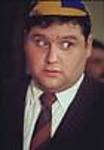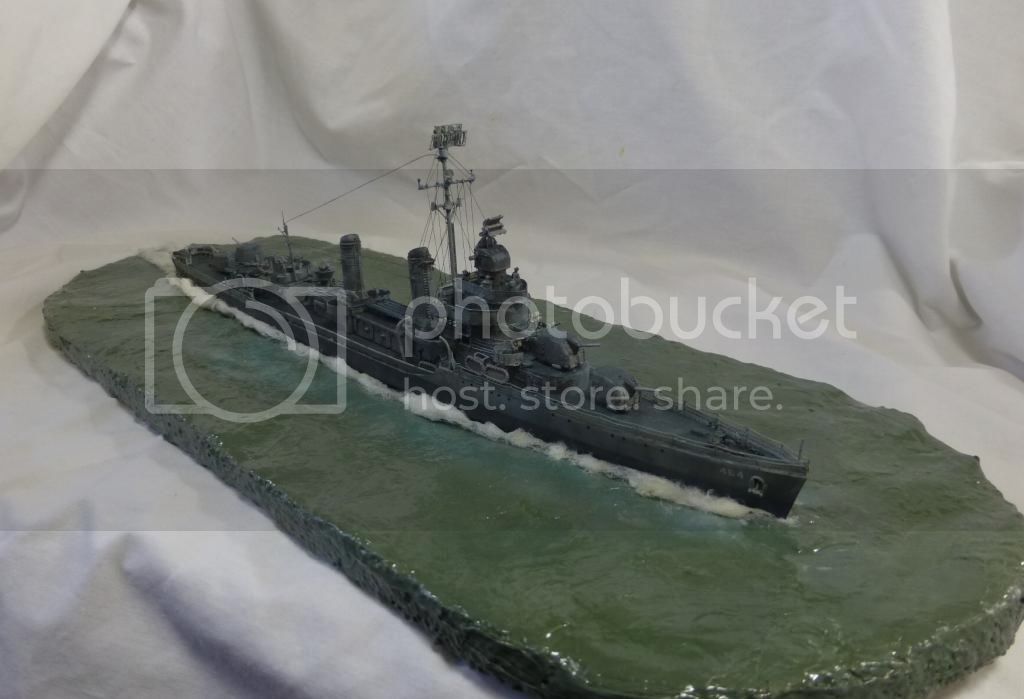I'm doing the old Revell 4 stacker as USS Ward. I want it in a water base. At 1/240 scale, the hull is very large. There's nearly 3/4 inch between waterline and keel so I think it has to be cut down to put it in a base. I'm going to put in Pearl Harbor on Dec 7. The water was calm but Ward was in GQ and approaching a spotted target at 25 knots, so there'd be a nice wake. I'm thinking of cutting it off at the bottom of the boot topping midship and resting it in styrofoam just a bit so the boot would be invisible midship but visible at the bow. Sound about right. Mess this up and the project is really hurt. Advice from wiser heads appreciated.
Eric
You are viewing the archived version of the site.
Go to modelshipwrights.com for the current dynamic site!
Go to modelshipwrights.com for the current dynamic site!
General Ship Modeling
Discuss modeling techniques, experiences, and ship modeling in general.
Discuss modeling techniques, experiences, and ship modeling in general.
Hosted by Jim Starkweather
Surgery tips for making waterline DD?
ebergerud

Joined: July 15, 2010
KitMaker: 297 posts
Model Shipwrights: 23 posts

Posted: Tuesday, December 29, 2015 - 10:44 AM UTC

CaptSonghouse

Joined: August 08, 2008
KitMaker: 1,274 posts
Model Shipwrights: 1,236 posts

Posted: Wednesday, December 30, 2015 - 12:23 AM UTC
Hi Eric!
Cool project. I suggest keeping the hull intact, particularly since it sounds like you are using a Styrofoam base. The results are much better when using an intact hull and carefully carving out a hole in the Styrofoam to cradle the ship model. Since I favor gatorboard (a very stiff form of foamcore) for most of my ship bases, it is a simple matter to cut a hole for the hull and then work my wave patterns afterwards rather than try to guess them out ahead of time with a waterline hull. Please see my "Counter Below" and "Hell at Lunga Point" dioramas on this site for my results with that Revell kit.
If you still feel you must cut, then use a hobby knife to scribe the separation line on the kit hull halves before assembly and then bend them apart. Using a razor saw to precut at the curve of the stern will help. These methods will give you more control than using a power cutting tool.
BTW, I am also working on a Ward scene for next December: LT Outerbridge assumed command of Ward on Dec 5th in Pearl Harbor. My scene will depict her casting off from the Allen and ex-Baltimore in Pearl Harbor on the early morning of Dec 6th to set off for her historic patrol. Looking forward to seeing your results!
--Karl
Cool project. I suggest keeping the hull intact, particularly since it sounds like you are using a Styrofoam base. The results are much better when using an intact hull and carefully carving out a hole in the Styrofoam to cradle the ship model. Since I favor gatorboard (a very stiff form of foamcore) for most of my ship bases, it is a simple matter to cut a hole for the hull and then work my wave patterns afterwards rather than try to guess them out ahead of time with a waterline hull. Please see my "Counter Below" and "Hell at Lunga Point" dioramas on this site for my results with that Revell kit.
If you still feel you must cut, then use a hobby knife to scribe the separation line on the kit hull halves before assembly and then bend them apart. Using a razor saw to precut at the curve of the stern will help. These methods will give you more control than using a power cutting tool.
BTW, I am also working on a Ward scene for next December: LT Outerbridge assumed command of Ward on Dec 5th in Pearl Harbor. My scene will depict her casting off from the Allen and ex-Baltimore in Pearl Harbor on the early morning of Dec 6th to set off for her historic patrol. Looking forward to seeing your results!

--Karl
ebergerud

Joined: July 15, 2010
KitMaker: 297 posts
Model Shipwrights: 23 posts

Posted: Wednesday, December 30, 2015 - 02:15 AM UTC
Checked both your builds - very nice indeed. I've written about Guadalcanal and thought about altering the kit for that very service, but I need a Minnesota Navy and, as the gun that fired the "first shot" (and hit something apparently) was manned by reservists from MN and the gun itself sits in front of the state capital building, so Dec 7 it is.
The last base I built I used stryofoam - copped a technique from Model Warship and used a cigarette lighter to create an undulating effect - worked good. Would that be an option with gatorboard?
Eric
The last base I built I used stryofoam - copped a technique from Model Warship and used a cigarette lighter to create an undulating effect - worked good. Would that be an option with gatorboard?
Eric

CaptSonghouse

Joined: August 08, 2008
KitMaker: 1,274 posts
Model Shipwrights: 1,236 posts

Posted: Wednesday, December 30, 2015 - 04:27 AM UTC
Hey Eric!
Are you the one who wrote "Touched By Fire" and "Fire in the Sky"? If so, superb works. Looking forward to the naval volume.
Anyway, I think going with a foamcore base will work. While gatorboard may be difficult to get in anything other than case lots (and pricey), standard foamcore sheets from the local craft store will work if you glue lengths of balsa on the underside, in an alternating herringbone pattern, to act as stiffeners to prevent warping when the wet material for the sea is applied later on the upper surface.
With foamcore, a hole to contain the intact hull can easily be fashioned and you'll be ahead of the game. (Besides, assembling the hull is easier when it's intact.)
For the sea, I am now favoring Celluclay--with a bit more water than usual added, it can be smoothed over and not resemble the soil it is usually employed for--and with a strong gloss coat after painting, it actually presents that peculiar pebbly texture the ocean exhibits. As for wave forming, Celluclay is unrivaled.
After that, fashion a wood or plastic border (or perhaps a picture frame) to go around the perimeter, and you're done! No need to use a cigarette lighter, either.
Good luck!
--Karl
Are you the one who wrote "Touched By Fire" and "Fire in the Sky"? If so, superb works. Looking forward to the naval volume.
Anyway, I think going with a foamcore base will work. While gatorboard may be difficult to get in anything other than case lots (and pricey), standard foamcore sheets from the local craft store will work if you glue lengths of balsa on the underside, in an alternating herringbone pattern, to act as stiffeners to prevent warping when the wet material for the sea is applied later on the upper surface.
With foamcore, a hole to contain the intact hull can easily be fashioned and you'll be ahead of the game. (Besides, assembling the hull is easier when it's intact.)
For the sea, I am now favoring Celluclay--with a bit more water than usual added, it can be smoothed over and not resemble the soil it is usually employed for--and with a strong gloss coat after painting, it actually presents that peculiar pebbly texture the ocean exhibits. As for wave forming, Celluclay is unrivaled.
After that, fashion a wood or plastic border (or perhaps a picture frame) to go around the perimeter, and you're done! No need to use a cigarette lighter, either.
Good luck!

--Karl
ebergerud

Joined: July 15, 2010
KitMaker: 297 posts
Model Shipwrights: 23 posts

Posted: Wednesday, December 30, 2015 - 12:46 PM UTC
Guilty as charged concerning the books. For a lot of reasons the naval volume is on the shelf. No idea why the marketing people released a note on a book that wasn't written.
Celluclay is very nice stuff indeed. I didn't experience any problem with shrinkage with 1/4 inch styrofoam (I'll use 1/2) last time, but I wonder if celluclay might do as well as paper for covering the styrofoam after melted into some sort of swell. I've only done a couple of bases so there's a learning curve. Great fun though - a little like junior high art class. Here's as far as I've gotten so far:
Eric

Celluclay is very nice stuff indeed. I didn't experience any problem with shrinkage with 1/4 inch styrofoam (I'll use 1/2) last time, but I wonder if celluclay might do as well as paper for covering the styrofoam after melted into some sort of swell. I've only done a couple of bases so there's a learning curve. Great fun though - a little like junior high art class. Here's as far as I've gotten so far:
Eric


CaptSonghouse

Joined: August 08, 2008
KitMaker: 1,274 posts
Model Shipwrights: 1,236 posts

Posted: Wednesday, December 30, 2015 - 10:21 PM UTC
Hey Eric!
Your work with "Touched By Fire" was groundbreaking because you dealt with the climatic and environmental issues in the Solomons in a relevant manner--other authors simply gloss over those facts and shortchange the reader.
Your approach with foam in your example looks great. I would even take the artist's gel and extended it to the base's sides to cover up all the holes and paint them the same color of the sea surface so you will have a 'slab of seawater' effect supporting your model.
If you are confident with texturing the foam into wavelets, then celluclay may be redundant. I like applying celluclay on a smooth surface because I favor the large scales (I'm really enjoying 1:200 scale for battleships and cruisers) and that's a lot of area that needs to be textured--carving would be too much work for me.
Keep on plugging, you will find that naval history and diorama work are a perfect match!
--Karl
Your work with "Touched By Fire" was groundbreaking because you dealt with the climatic and environmental issues in the Solomons in a relevant manner--other authors simply gloss over those facts and shortchange the reader.
Your approach with foam in your example looks great. I would even take the artist's gel and extended it to the base's sides to cover up all the holes and paint them the same color of the sea surface so you will have a 'slab of seawater' effect supporting your model.
If you are confident with texturing the foam into wavelets, then celluclay may be redundant. I like applying celluclay on a smooth surface because I favor the large scales (I'm really enjoying 1:200 scale for battleships and cruisers) and that's a lot of area that needs to be textured--carving would be too much work for me.
Keep on plugging, you will find that naval history and diorama work are a perfect match!

--Karl
 |






